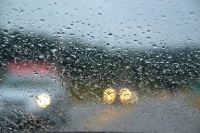You have to love waking up to the sound of rain as it lands on many different surfaces. Throw in some trembling thunder and luminous lightning too and I am transported to a sound paradise. The smallest amount of rain or a torrent of water can make amazing sounds. But, where does that water go?
 Well, most people in and near the City of Milwaukee live in a watershed. What is that, you may ask? If you don’t know, take a moment to take a guess. I’ll give you a minute. Don’t be shy. Come on, no guess is ever wrong. If you think of more than one guess, even better!
Well, most people in and near the City of Milwaukee live in a watershed. What is that, you may ask? If you don’t know, take a moment to take a guess. I’ll give you a minute. Don’t be shy. Come on, no guess is ever wrong. If you think of more than one guess, even better!
A watershed is an area of land where water travels. The easiest model is to think of it like a funnel. No matter where in a funnel the water lands, it is always guided to the bottom and out the spout. Same for a water shed: no matter where in that watershed water lands, it is guided to the same location. All watersheds have a high point and a low point to them. This allows gravity to pull water into streams, rivers, lakes, and oceans. No two watersheds are the same. Rain water can also be absorbed by soils and plants. Water in some soils can then be released back into underground water sources. There is one more place where water can go, and it is under your feet.
 Storm drains guide rain water to the sewer. Many turns and connections create many routes for water to take, but it all leads to the same location. This is usually a water treatment plant. Jones Island in Milwaukee is one of many places that do this. So, in some odd fashion, an artificial watershed of sewers is created. A sewershed, if you will. It is a system that has helped many cities across the country. However, Mother Nature likes to give us more water than usual. So much water fills up the system too quickly and some problems are created. No one likes having water flow in reverse from drain in your home. Having so much concrete and less natural green space adds to the problem.
Storm drains guide rain water to the sewer. Many turns and connections create many routes for water to take, but it all leads to the same location. This is usually a water treatment plant. Jones Island in Milwaukee is one of many places that do this. So, in some odd fashion, an artificial watershed of sewers is created. A sewershed, if you will. It is a system that has helped many cities across the country. However, Mother Nature likes to give us more water than usual. So much water fills up the system too quickly and some problems are created. No one likes having water flow in reverse from drain in your home. Having so much concrete and less natural green space adds to the problem.

Nature helps us out in many different ways. There are plants who specialize in absorbing water better than others. True water experts. Taking out the concrete and asphalt for a greener space provides a home to these expert plants. Rain gardens and bioswales are perfect examples for this green infrastructure. Rain barrels are just as helpful in collecting and storing rain water to reduce the amount that goes into the sewershed.
Explore the outdoors and challenge yourself to a scavenger hunt of some of these green features throughout your neighborhood. Also, do you know what watershed you live in? Discover which one you reside in and learn about your plant and animal neighbors. There may just be something unique to your watershed! 





